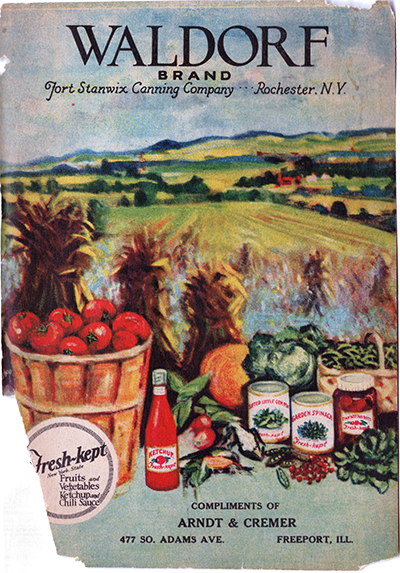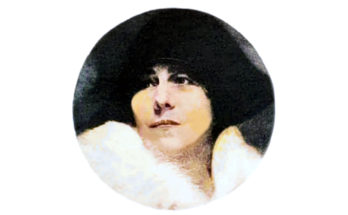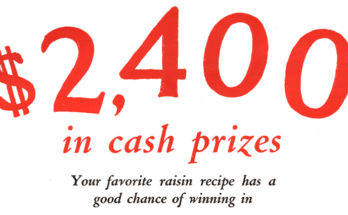
This booklet is the Waldorf brand from Fort Stanwix Canning Co. in Rochester, New York. There is also an identical book from Stanwix, Mistletoe brand, same year. Then, this colorful booklet is for another Rochester canner, Winters & Prophet’s Canning Co. producing their Princess Royal brand. All three booklets, except for the brand and the canning company were identical, and all written in 1925 by Anne L Pierce.
Because New York Canners Inc. purchased all these canning companies, all who independently produced their own private brands (at least originally), what we may be seeing here is economy of scale. Efficiencies like this were made by the parent company. There could be other booklets, as New York Canners also purchased Burt Olney Canning Company and Cobb Preserving Co. according to these bottle collectors and awesome researchers.
An Aside: A fun idea is to have a company where you upload your own picture, and you’re sent standard size labels to adhere over your canned products–I hope they’re reusable! Imagine, a pantry with can labels of your family portrait. –Dear me, I just went off on a tangent!
History of “Winters & Prophet” Canning Co.
In 1878 John C. Winters moved from NYC to Mount Morris, NY and a year later went into a partnership with John M. Prophet, also of NYC, forming Winters & Prophet Canning Company on N. Main St., Mount Morris. Before them, there was only a meat market and a clothing store in business in the town.
They built a new canning factory circa 1900, and expanded with factories at Genesco, Avon and Medina. They were run successfully until “some years ago” before 1932 when they sold to New York Canners Inc.
ANNE PIERCE, author
Anne Pierce, the author, was synonymous with Pure Foods and Truth in Labeling, and a former popular columnist at the New York Herald Tribune. Her professional life initially was connected to the career of Harvey W. Wiley, “Father of the Pure Food and Drugs Act” of 1906, as she worked with him, even when his place of employment changed, and they wrote a book together.
Harvey W. Wiley had been the chief chemist at USDA since before it was the officially the USDA in 1883. Anne Lewis Pierce graduated George Washington University, 1897, and became the editor at USDA, Bureau of Chemistry.
“…All through the 1880s and 1890s, pure-food bills were introduced into Congress–largely through his [Wiley’s] work–and all were killed. Powerful lobbies had established themselves. To bring his cause to the public, and with a budget of $5,000, Wiley organized in 1902 a volunteer group of healthy young men, called the Poison Squad, who tested the effects of chemicals and adulterated foods on themselves. Women banded together, notably in the Federated Women’s Clubs, for political clout. Major canners became supporters of the legislation and voluntarily abandoned the use of questionable chemicals. Finally, the battle was won on June 30, 1906, when President Theodore Roosevelt signed the Pure Food and Drugs Act, largely written by Wiley, who was then appointed to oversee its administration….”
— FDA dot gov adapted from Good Housekeeping Magazine
Wiley left the USDA in 1912 and was asked by Good Housekeeping Magazine to set up and direct the Bureau of Foods, Sanitation and Health at the Magazine. He hired Anne Pierce as Assistant Director. During this time, Wiley wrote, and Anne Pierce “arranged” the 1914 book, 1001 tests of foods beverages and toilet accessories, good and otherwise why they are so.
She left Good Housekeeping Magazine soon after, and Wiley stayed until abt. 1931.
Anne Pierce became the Director of the New York Herald Tribune Institute. Perhaps the Herald Tribune was inspired by the Good Housekeeping Seal of Approval as they established their own seal, “Tested and Endorsed by The Tribune Institute.”
Pierce wrote a column at the newspaper — she was so knowledgeable, to say it was merely a food column does not do it justice. She was also editor of the Children’s Tribune, and worked on a myriad of other projects.
As an example, beside writing a newspaper column she appears to be pretty busy in 1924:
1924 — office at 30 Fifth Ave NY where she acted as consultant on the merchandising of foods and household appliances.
1924 — the Institute exhibited a model kitchen “which was swamped by women eager to obtain increased efficiency in their homes.” Miss Anne Pierce traveled for the Institute and spoke on the topic of Household Refrigeration being present at meetings of the Michigan, Tri-State, Ohio, Massachusetts and Eastern Ice Men’s Association.
1924 — She wrote an article about about truth in labeling for Canning Age [Portrait & Article] The Institute was described as “one of the most influential factors with the housewife in the East in matters pertaining to the consumption of food. Miss Pierce is eminently qualified to speak for the consumer from her constant daily contact with many thousands of her readers.”
I can confirm that she was at the New York Herald Tribune Institute from at least 1916 to 1924.
In 1930 she was an assistant editor in publishing, a few blocks up from Washington Square Park, 61 W 9th St. But by 1940, age 69, she moved in with (possibly her twin) sister and her sister’s family in Brooklyn, 1228 Prospect Ave. — more of a family environment. She claimed social security retirement in March, 1942. By 1950 at 77 years, she was back at her old apartment at 61 West 9th St., working as editor of Writer. Journal Paper, and living with Florence Wilson, widowed, who worked at a newspaper.
She died at 85 years old, Nov 7, 1958 in New York.


